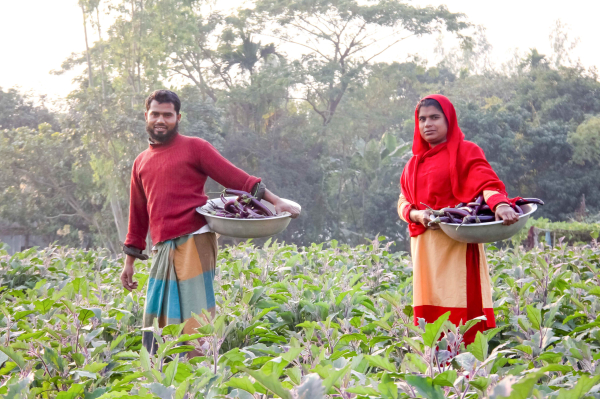
n agricultural biotechnology, Bangladesh stands as a symbol of progress and innovation. Over the years, this South Asian nation has equipped itself with state-of-the-art technology and innovation, starting with Plant Tissue Culture in 1990 and becoming a biotechnology pioneer with Bt Brinjal’s approval in 2013.
It would only be fair to highlight the milestones by acknowledging the significant stepping-stones in between.
The initial step was undertaken in 1993 with the establishment of the National Committee on Biotechnology Product Development, marking the beginning of a more structured approach to biotechnological research and development (R&D).
Shortly after, in 1997, workshops on biosafety regulation were organized, fostering awareness while paving the way for robust regulatory frameworks. In 1999, the National Institute of Biotechnology was established for multidimensional biotechnological research, where scientists could explore and innovate. Following that, 2006 marked a turning point for socioeconomic development using technology as the government adopted its first National Policy Guidelines on Biotechnology.
Rice production has tripled
This remarkable journey reflects Bangladesh’s commitment to harnessing scientific innovations to benefit the people.
Fast forward to the present, 50 years since independence, this once war-torn nation has made remarkable strides in agriculture. Rice production has tripled, wheat production has doubled, there’s been a fivefold surge in vegetable yields, and maize production has increased tenfold. Securing an average food growth rate of 3 percent while population growth at 1.9 percent. It is safe to say that agricultural mechanization and technological advancement have contributed drastically to the prosperous agro-sector growth, enabling Bangladesh to stand as the second-largest producer of staple food grains and jute worldwide.
Even during times of adversity, such as the COVID-19 pandemic, Bangladesh’s agricultural sector sustained the country’s economy. While economies around the world struggled with plummeting GDPs, our economy stood resilient. Such experiences teach us to empower agriculture more than ever before, particularly as the weight of food insecurity looms on the horizon.
Transformation addresses malnutrition
A key facet of Bangladesh’s journey has been its pursuit of faster and more inclusive rural growth. The endeavor was made possible through agricultural diversification, shifting from traditional rice cultivation to higher-value crops. This transformation addresses malnutrition, accelerates income growth, and fosters job opportunities, particularly for women and the youth.
Likewise, Bangladesh takes pride in its livestock and fisheries. Despite struggling with inadequate government support, these sectors hold the potential to combat malnutrition, boost income, and create employment.
Bangladesh’s agricultural sector has consistently demonstrated the capacity to adapt and generate value exponentially. Yet, we could learn more from Japan’s efficient resource mobilization and value creation strategies. Doing so would enable Bangladesh to elevate its current agricultural value further from 48 billion dollars to 118 billion dollars annually.
Focused on agricultural innovation and adaptation
During these 50 years of unwavering commitment, the jute sector was central to Bangladesh’s economic scenario. It is a major cash crop for thousands of small farm households and is the country’s largest agricultural export commodity. The livelihoods of approximately 25 million people, which is nearly one-fifth of the population, hinge on various jute-related activities, including but not limited to manufacturing and trade.
Bangladesh accounts for a significant share of global jute production, so the nation is poised to expand further, particularly by adopting genetically modified jute varieties. Despite the alarming reality of climate change, Bangladesh remains focused on agricultural innovation and adaptation.
While subsistence farming once dominated Bangladesh’s agricultural terrain, a notable shift towards commercial farming with high-value crops, fisheries, and animal products has emerged. This transition promises further poverty reduction through enhanced health, nutrition, and education outcomes.
Between 2005 and 2010, a substantial proportion (approximately 90 percent) of poverty reduction in Bangladesh was attributed to increased farm income. Agriculture’s role in enhancing the lives of millions cannot be overstated but is evident from the progressive statistical reports. In recognition of the adverse environmental impacts of conventional farming and risks associated with climate change, Bangladesh has adopted alternative approaches.
These include alternative wetting and drying (AWD) irrigation methods, the utilization of deep-placed briquette urea fertilizer, diversification into non-rice crops, and the incorporation of straw stubbles into rice paddies, thus abstaining from burning crop residues. These measures curtail emissions and facilitate the enrichment of soil organic matter.
In the face of climate change vulnerabilities, Bangladesh has embraced climate-smart agricultural (CSA) interventions. Traditional practices like the Sorjan system, vertical gardens, floating bed cultivation, and rooftop gardening are rapidly gaining popularity. Additionally, strengthening information services, especially climate forecasting, empowers farmers to adapt their practices to changing conditions, enhancing nation-wide resilience.
Powerful global players
Moving forward, adopting innovative strategies will enable Bangladesh to conquer the global concerns of food insecurity, climate change, global warming, and inflation. These strategies include a well-timed government action plan, joint efforts of hardworking farmers, subsidies on agricultural equipment, extensive mechanization, efficient markets, and strong partnerships between scientists, extension officers, and farmers.
Implementing and accomplishing sustainable goals necessitates educating skilled farmers, efficient machinery utilization, improved infrastructure, mass production of high-quality crops, enhanced market access, and dedicated R&D investments. These prerequisites are key to propelling Bangladesh’s agriculture into uncharted territory, potentially enlisting it among powerful global players.
As the most climate-vulnerable nation, Bangladesh’s odyssey from relief to resilience in agriculture is truly awe-inspiring. Its dedication to sustainable practices, diversification, and innovation offers invaluable lessons to the world on navigating adversity and sets a compelling example for other nations to emulate.


